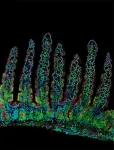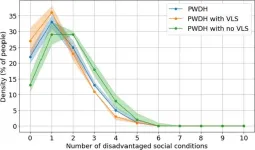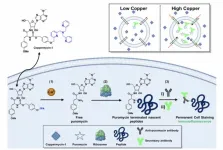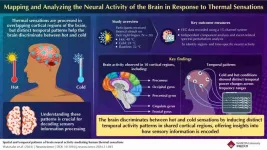(Press-News.org) Seattle, WASH.—January 22, 2025—The human immune system is like an army of specialized soldiers (immune cells) each with a unique role to play in fighting disease. In a new study published in Nature, led by scientists at the Allen Institute, La Jolla Institute for Immunology, and UC San Diego, researchers reveal how cells known as tissue-resident memory CD8 T cells, play unique and specialized roles based on where they are located within the small intestine. Tissue-resident memory cells provide a local first line of defense against re-infection and call for “backup” from other immune cells and are also critical for maintaining peace in a tissue exposed to many outside pathogens.
This discovery sheds light on how tissue-resident memory CD8 T cells adapt to their location in the body, ensuring a coordinated and effective immune response and how microenvironments and cellular interactions shape this location-specific adaptation. Ultimately, location matters, and this understanding could also lead to improved immunotherapy and vaccines.
Specialized Roles Based on Location
The study shows that tissue-resident memory CD8 T cells in the small intestine are diverse with distinct responsibilities, and their position inside the gut’s architecture dictates what they do.
The frontline: At the villus tips, a subset of tissue-resident memory CD8 T cells with a higher killing capacity are positioned like guards in watchtowers. These cells are designed to attack invading pathogens immediately, preventing infections from spreading further.
Reinforcements: In a pocket of cells called the crypts, a different subset of tissue-resident memory CD8 T cells, which act as reserve forces, stand ready to respond should the body encounter the same pathogen in the future. These cells provide long-lasting immunity.
“What really struck me is that we have been able to see that immune cells in distinct locations have these special functions,” said Maximilian Heeg, M.D., one of the study’s lead co-authors and investigator at the Allen Institute. “They’re strategically positioned in the small intestine to fulfill their function, and this is the key finding from the paper.”
These differences ensure the immune system can react quickly to immediate threats while simultaneously maintaining a backup defense for long term protection.
“In response to infection, immune cells stream into tissues to fight infection and help repair damage. Importantly, these cells ‘talk to’ the tissue cells to coordinate the immune response. In this study, we can now visualize how the functional state of an immune cell relates to which cells and signals are found in different neighborhoods or regions of the tissues. This new knowledge of how the immune system works in tissues is game changing as we explore how to enhance immune protection while avoiding damaging inflammation,” said Ananda W. Goldrath, Ph.D., executive vice president of the Allen Institute for Immunology.
Understanding Microenvironments and Cellular Interactions
Using advanced transcriptional profiling techniques, the researchers mapped the genetic instructions that instruct the behavior of tissue-resident memory CD8 T cells based on their location.
“I am most excited about the possibilities our new approaches bring: Studying immune cells in their unperturbed natural environments at high plex, throughput and resolution,” said Miguel Reina-Campos, Ph.D., study co-author and assistant professor at La Jolla Institute for Immunology.
The findings provide insight for designing better immunotherapies and vaccines. By targeting the mechanisms that direct tissue-resident memory CD8 T cells to specific sites inside a tissue and enhance their capabilities, researchers hope to develop treatments to boost the immune system’s effectiveness and keep us healthy.
“One part of this work was discovering causal relationships between well-characterized genes and CD8 T cell spatial and transcriptional phenotypes,” said study co-first author Alex Monell, a UC San Diego graduate student working with Goldrath. “We are expanding our CRISPR pooled spatial screening to profile the impacts of many types of genetic perturbations at once within CD8 T cells with an overarching goal of finding and manipulating modulatory mechanisms of tissue-specific immunity.”
Future Research Goals
This work highlights the importance of anatomical niches in shaping immune responses and establishes a framework for studying how immune cells interact with their environment. It presents new approaches in treating chronic diseases, infections, and inflammatory disorders by leveraging the unique dynamics of tissue-resident memory immune cells in barrier tissues.
Moving forward, the group is focused on understanding how this knowledge can be used to therapeutically target our immune responses.
About the Allen Institute
The Allen Institute is an independent, 501(c)(3) nonprofit research organization founded by philanthropist and visionary, the late Paul G. Allen. The Allen Institute is dedicated to answering some of the biggest questions in bioscience and accelerating research worldwide. The Institute is a recognized leader in large-scale research with a commitment to an open science model. Its research institutes and programs include the Allen Institute for Brain Science, the Allen Institute for Cell Science, the Allen Institute for Immunology, and the Allen Institute for Neural Dynamics. In 2016, the Allen Institute expanded its reach with the launch of The Paul G. Allen Frontiers Group, which identifies pioneers with new ideas to expand the boundaries of knowledge and make the world better. For more information, visit alleninstitute.org.
# # #
Media Contact
Liz Dueweke
Sr. Communications and Media Relations Specialist
liz.dueweke@alleninstitute.org
206-519-8527
END
New research reveals how location influences how our immune system fights disease
Findings could pave the way for improved immunotherapies and vaccines
2025-01-22
ELSE PRESS RELEASES FROM THIS DATE:
AI in cell research: Moscot reveals cell dynamics in unprecedented detail
2025-01-22
Thanks to a new technology called Moscot (“Multi-Omics Single-Cell Optimal Transport”), researchers can now observe millions of cells simultaneously as they develop into a new organ—for example, a pancreas. This groundbreaking method was developed by an international research team led by Helmholtz Munich and has been published in the renowned journal Nature.
Until now, biologists had only a limited understanding of how cells develop in their natural environment—for instance, when they form an organ in the ...
New study finds social programs could reduce the spread of HIV by 29%
2025-01-22
January 22, 2025
New Study Finds Social Programs Could Reduce the Spread of HIV by 29%
Although HIV was used as a case study, the UMass Amherst researchers say their assessment tool has applications for other diseases
AMHERST, Mass. — Researchers at the University of Massachusetts Amherst have quantified the impacts of a constellation of social factors on the spread of HIV. Their study, published in Health Care Management Science, found that a hypothetical 100% effective intervention addressing barriers to HIV treatment and care from depression, homelessness, ...
SIDS discovery could ID babies at risk of sudden death
2025-01-22
New University of Virginia School of Medicine research revealing the fingerprints of Sudden Infant Death Syndrome within blood samples could open the door to simple tests to identify babies at risk.
The findings also represent an important step forward in unraveling the causes of SIDS, an unexplained condition that is the No. 1 killer of babies between amonth and a year old.
The UVA researchers analyzed blood serum samples collected from infants who died ...
Ozone exposure linked to hypoxia and arterial stiffness
2025-01-22
Ozone (O3) exposure may reduce the availability of oxygen in the body, resulting in arterial stiffening due to the body’s natural response to create more red blood cells and hemoglobin, according to a study published today in JACC, the flagship journal of the American College of Cardiology.
“Researchers found that even brief exposure to elevated ozone levels reduced blood oxygen saturation, triggered hypoxia-related biomarkers, and increased arterial stiffness, highlighting the novel connection between ozone exposure and arterial stiffness, demonstrated through comprehensive biomarker analysis in a high-altitude ...
Princeton Chemistry develops copper-detection tool to discover possible chelation target for lung cancer
2025-01-22
The Chang Lab at Princeton Chemistry continues in its mission to elucidate the role of metal nutrients in human biology: last year, iron; this year, copper. The lab’s first paper of 2025 showcases its development of a revelatory sensing probe for the detection of copper in human cells and then wields it to uncover how copper may be regulating cell growth in lung cancer.
Researchers also offer a possible treatment modality in which copper chelation shows promising results in certain lung cancers where cells have two related phenomena: a heightened transcription factor responding to oxidative stress and a diminished level of bioavailable copper.
Their collaborative paper, A histochemical ...
Drug candidate eliminates breast cancer tumors in mice in a single dose
2025-01-22
Despite significant therapeutic advances, breast cancer remains a leading cause of cancer-related death in women. Treatment typically involves surgery and follow-up hormone therapy, but late effects of these treatments include osteoporosis, sexual dysfunction and blood clots. Now, researchers reporting in ACS Central Science have created a novel treatment that eliminated small breast tumors and significantly shrank large tumors in mice in a single dose, without problematic side effects.
Most breast cancers are ...
WSU study shows travelers are dreaming forward, not looking back
2025-01-22
PULLMAN, Wash. – When it comes to getting people to want to go places, the future is ever more lovely than the past, according to a new Washington State University-led study in the Journal of Hospitality and Tourism Research.
Led by Ruiying Cai, an assistant professor in the Carson College of Business, the study found that forestalgia-focused destination ads—those that emphasize an idealized future—are more effective at enticing travelers to click the purchase button for a vacation than ads based on fond recollections. The research also revealed that forestalgia advertising is particularly effective for getting people to book near-term trips, as imagining ...
Black immigrants attract white residents to neighborhoods
2025-01-22
COLUMBUS, Ohio – Black immigrants moving into a neighborhood can help shift the overall racial and ethnic character of the area, a new study suggests.
A researcher from The Ohio State University found that when Black immigrants move into a majority native-Black neighborhood, there is an increase in the white population moving in while native Black residents move out.
“Blackness can’t be treated as a monolith within the United States today, where there is a growing Black immigrant population,” said Nima Dahir, author of the study and assistant professor of sociology at Ohio State.
“There is a lot of complexity ...
Hot or cold? How the brain deciphers thermal sensations
2025-01-22
When we touch something hot or cold, the temperature is consciously sensed. Previous studies have shown that the cortex, the outermost layer of the brain, is responsible for thermal sensations. However, how the cortex determines whether something is hot or cold is not well understood. Thermal sensitivity is often subjective and individualistic; what is a comfortable temperature for someone might be too hot or too cold for someone else.
In a new study, Professor Kei Nagashima from the Body Temperature and Fluid Laboratory, Faculty of Human Sciences, ...
Green tea-based adhesive films show promise as a novel treatment for oral mucositis
2025-01-22
Green tea shines as a natural powerhouse of antioxidants, with catechins leading the charge among its polyphenols, which protect cells from oxidative stress. These powerful compounds neutralize harmful free radicals generated during cancer treatment. The anti-inflammatory properties of green tea can alleviate oral mucositis, a painful inflammation of the mouth lining often caused by chemotherapy and radiation.
Building on these benefits, researchers at the Tokyo University of Science (TUS), Japan, have explored the potential of tea catechins in developing ...
LAST 30 PRESS RELEASES:
Electrodes created using light
Second-hand gift-giving is a well-deliberated decision
How human interaction drove evolution to make bears less aggressive
National Poll: Few parents offer teens guidance on healthy eating during holiday season
Cannabis derivatives could provide new ovarian cancer treatments
Raising strong yeast as a petroleum substitute
Clues to the origin of hot Jupiters hidden in their orbits
Canada’s reduced pledge to Global Fund will impact domestic health
1 in 4 children with major traumatic injuries not cared for in pediatric trauma centres
Duke and Duke-NUS’ joint cross-population research to uncover "East-West" differences in disease and care
Scientists to ‘spy’ on cancer- immune cell interactions using quantum technology breakthrough
Tech savvy users have most digital concerns
Making lighter work of calculating fluid and heat flow
Normalizing blood sugar can halve heart attack risk
Lowering blood sugar cuts heart attack risk in people with prediabetes
Study links genetic variants to risk of blinding eye disease in premature infants
Non-opioid ‘pain sponge’ therapy halts cartilage degeneration and relieves chronic pain
AI can pick up cultural values by mimicking how kids learn
China’s ecological redlines offer fast track to 30 x 30 global conservation goal
Invisible indoor threats: emerging household contaminants and their growing risks to human health
Adding antibody treatment to chemo boosts outcomes for children with rare cancer
Germline pathogenic variants among women without a history of breast cancer
Tanning beds triple melanoma risk, potentially causing broad DNA damage
Unique bond identified as key to viral infection speed
Indoor tanning makes youthful skin much older on a genetic level
Mouse model sheds new light on the causes and potential solutions to human GI problems linked to muscular dystrophy
The Journal of Nuclear Medicine ahead-of-print tip sheet: December 12, 2025
Smarter tools for peering into the microscopic world
Applications open for funding to conduct research in the Kinsey Institute archives
Global measure underestimates the severity of food insecurity
[Press-News.org] New research reveals how location influences how our immune system fights diseaseFindings could pave the way for improved immunotherapies and vaccines




